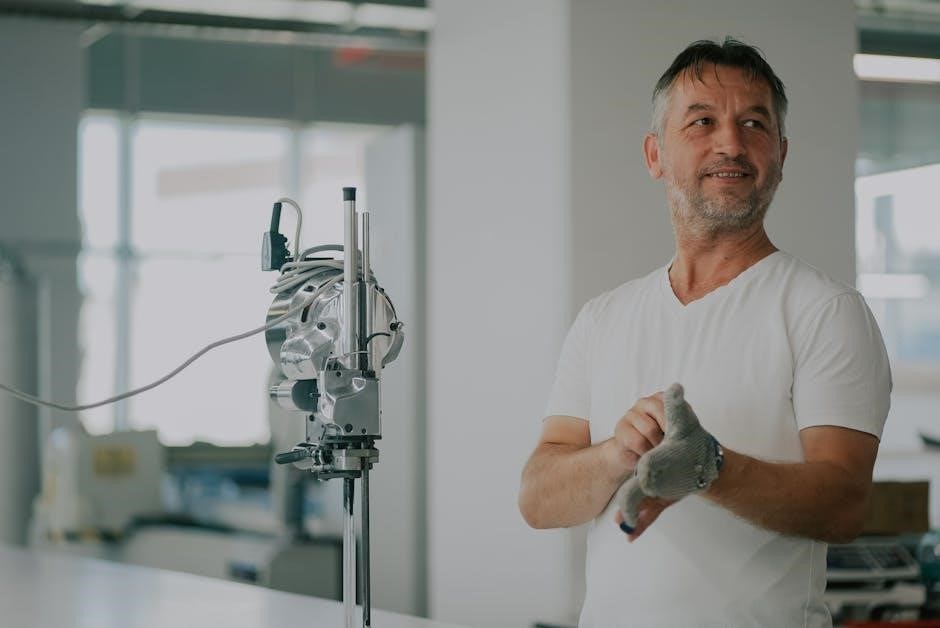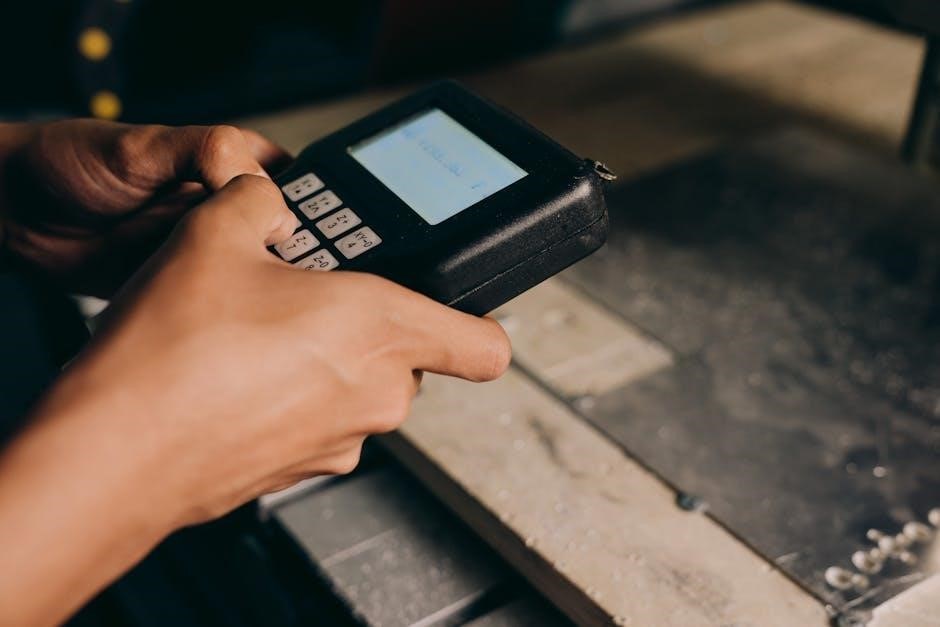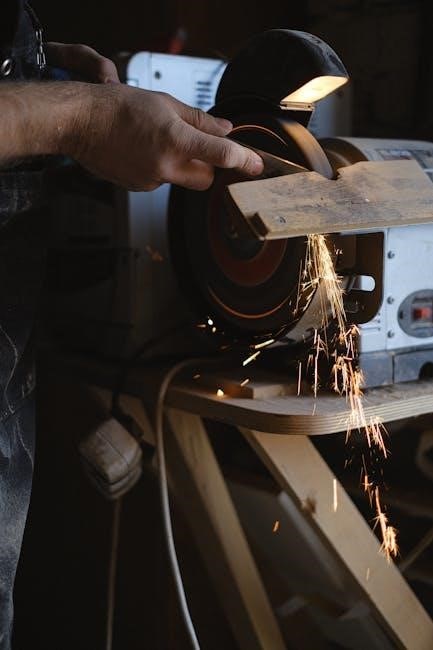tens machine user manual
Lost your tens machine user manual? No worries! Get back to soothing relief with our easy guide. Download now and say goodbye to pain!
TENS Machine User Manual: A Comprehensive Guide
Welcome to your comprehensive guide! This manual simplifies using a TENS unit, explaining proper settings, pad placement, and step-by-step instructions. Learn how to achieve effective pain relief at home or on-the-go with your TENS device.
Understanding TENS Therapy
TENS, or Transcutaneous Electrical Nerve Stimulation, is a non-invasive, drug-free method of pain relief. The TENS unit delivers mild, safe electrical signals through electrodes placed on the skin to stimulate nerves. This stimulation can help control pain by prompting the body to release endorphins, its natural painkillers. By stopping the pain signals in the brain, a TENS machine provides relief from acute and chronic pain. TENS therapy is adaptable for various conditions, making it a versatile option for managing discomfort. Consulting with a healthcare professional will ensure proper electrode placement for specific pain areas, optimizing the therapy’s effectiveness.

What is a TENS Machine?
A TENS machine is a small, portable, battery-powered device that uses mild electrical signals to help control pain. Electrodes are placed on the skin to deliver these signals to nerves.
How TENS Works: Pain Relief Mechanisms
TENS (Transcutaneous Electrical Nerve Stimulation) reduces pain by sending electrical pulses through the skin, aiming to block pain signal transmissions to the spinal cord and brain. The electrical stimulation can trigger the release of endorphins, the body’s natural painkillers, and other substances that help stop pain signals. By targeting nerves under the skin with electrodes, the TENS unit helps to manage and alleviate pain. TENS therapy aims to start your body’s own pain killers, therefore, the TENS device will not give you an electrical shock. The stimulation also can help muscles, joints, and tendons.

Initial Setup and Preparation
Before use, ensure your TENS unit is ready. This involves charging or inserting batteries correctly and preparing the skin for electrode placement. Proper setup ensures effective and comfortable pain relief therapy.
Charging or Inserting Batteries
Before the first use, it’s crucial to power your TENS unit correctly. Most units are either battery-operated or rechargeable; For battery models, double-check that the batteries are properly inserted, aligning with the polarity markings inside the compartment to ensure correct use. Incorrect insertion can prevent the device from powering on.
If your TENS unit is rechargeable, use the provided charger. Follow the manufacturer’s instructions for charging times. A full charge ensures optimal performance. Don’t use the device while it is charging unless the manufacturer explicitly states it is safe. A properly powered device ensures effective pain management.
Electrode Pad Placement: Key Considerations
Proper electrode placement is critical for effective TENS therapy. Always apply electrodes to clean, dry, and unbroken skin. Cleanse the area with water or rubbing alcohol and allow it to air dry before application. Avoid placing pads over bony prominences, wounds, tumors, or the front of the neck.
Position the electrodes on or near the pain area, ensuring they are at least one inch apart. For lower back pain, assistance may be needed for correct placement. Refer to detailed pad placement guides for specific pain types. Correct placement maximizes pain signal blocking and stimulation of endorphins.

Operating the TENS Unit
This section details how to power on your TENS unit, select appropriate therapy modes, and adjust intensity levels for optimal pain relief. Begin with the lowest intensity setting for comfort.
Powering On and Selecting Modes
To begin, ensure your TENS unit is properly charged or has fresh batteries inserted. Press the designated on/off button to power up the device. The unit typically starts in a default mode, often BURST 1. Consult your user manual to understand the available modes, which may include continuous, burst, modulation, or specific pre-programmed settings for different pain types.
Press the ‘MODE’ button to cycle through these options, selecting the one recommended by your healthcare professional or that feels most suitable for your pain. Remember that TENS can benefit some people and relieve or reduce some, but not all, types of pain;
Adjusting Intensity Levels
Once the TENS unit is powered on and a mode is selected, carefully adjust the intensity. Use the intensity control, often an on/off switch that doubles as a level adjuster, to gradually increase the electrical pulse. The TENS 7000, for example, has a range of 0-100 mA with eight intensity levels. Begin at the lowest level. Slowly increase the intensity until you feel a comfortable tingling sensation.
If the sensation is too weak, increase the intensity; if uncomfortable or causing muscle contractions, decrease it. Remember, the goal is pain relief, not discomfort. Use the ‘WEAK/STRONG’ button to fine-tune the stimulation.
Electrode Pad Care and Maintenance
Proper care ensures longevity and hygiene. This section covers cleaning, storage, and replacement. Patches may last up to 2 weeks with proper care. Regular maintenance optimizes performance and extends the life of your electrode pads.
Cleaning and Storage of Pads
To maximize the lifespan of your TENS unit electrode pads, proper cleaning and storage are crucial. Always ensure the TENS unit is switched off before handling the pads. After each use, gently wipe the adhesive surface of the pads with a slightly damp cloth or sponge. Use water only, avoiding soaps or other cleaning agents, as these can damage the adhesive and irritate the skin. Allow the pads to air dry completely before storing them.
Once dry, replace the pads on the original plastic liner or a similar clean, non-porous surface. This helps to prevent the adhesive from drying out or becoming contaminated. Store the pads in a cool, dry place away from direct sunlight and extreme temperatures. Proper storage maintains their adhesiveness and ensures optimal performance for future treatments, saving you money on frequent replacements.
Replacing Electrode Pads
Electrode pads are consumables and will eventually need replacement. The lifespan of the pads depends on usage frequency, skin type, and how well they are maintained. A clear sign that your pads need replacing is when they lose their adhesiveness and no longer stick firmly to the skin. This results in poor electrical conductivity and reduced effectiveness of the TENS therapy.
Replace pads when they are visibly damaged, dirty, or no longer provide a comfortable and secure connection. When replacing, ensure the new pads are compatible with your TENS unit. Clean the skin where the new pads will be placed with water to remove oils and debris. Attach the new pads firmly, following the recommended placement guidelines for optimal pain relief. Discard used pads responsibly.

Safety Precautions and Contraindications
Before using a TENS machine, understand safety measures. Know when to avoid use, such as during pregnancy or with pacemakers. Be aware of potential adverse reactions and always consult with a healthcare professional.
When NOT to Use a TENS Machine
Avoid using a TENS machine in specific situations to prevent potential harm. Never apply electrodes to the head, throat, eyes, or chest. It is also not recomended to use over a pacemaker, wounds, or tumors. Safety during pregnancy or delivery is unconfirmed. Electronic equipment like ECG monitors may malfunction with TENS in use.
Do not use if you have undiagnosed pain, as TENS may mask underlying conditions. Always apply electrodes only to clean, dry, unbroken skin. Consulting a healthcare professional or physical therapist is crucial to determine if TENS is suitable and safe for your individual needs.
Potential Adverse Reactions
TENS devices are generally safe, but some individuals may experience adverse reactions. Skin irritation or redness beneath the electrode pads is a common issue, often due to poor skin preparation or prolonged use. Allergic reactions to the electrode gel are also possible, manifesting as itching or rash.
In rare cases, improper electrode placement or high intensity settings may cause muscle twitching or discomfort. Always start with the lowest intensity and gradually increase as needed. If you experience any unusual or severe symptoms, discontinue use and consult with a healthcare professional. TENS therapy might not be suitable for everyone, so always follow professional advice.
Troubleshooting Common Issues
Encountering problems with your TENS unit? Here’s how to troubleshoot common issues. If the unit won’t power on, check the batteries are properly inserted or the device is adequately charged. Weak or no sensation often results from incorrect electrode placement or dry electrode pads. Ensure pads are clean, moist, and firmly attached to the skin.
If experiencing skin irritation, try hypoallergenic pads and ensure the skin is clean before application. For uneven stimulation, check the lead wires are securely connected. If issues persist, consult the user manual, seek advice from a professional, or consider replacing the TENS unit or electrode patches.

